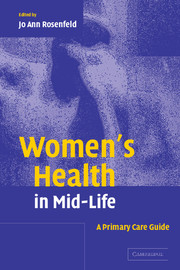Book contents
- Frontmatter
- Contents
- List of contributors
- 1 Introduction
- Part I Health promotion
- Part II Hormonal changes
- Part III Disease prevention
- Part IV Cancer prevention
- 16 Breast cancer: screening and prevention
- 17 Cervical cancer: prevention, screening, and early detection
- 18 Endometrial cancer: prevention, screening, and early detection
- 19 Ovarian cancer: prevention, screening, and early detection
- 20 Colon, lung, and skin cancer: screening and prevention
- 21 Common gastrointestinal and urinary problems
- Index
- References
19 - Ovarian cancer: prevention, screening, and early detection
from Part IV - Cancer prevention
Published online by Cambridge University Press: 21 August 2009
- Frontmatter
- Contents
- List of contributors
- 1 Introduction
- Part I Health promotion
- Part II Hormonal changes
- Part III Disease prevention
- Part IV Cancer prevention
- 16 Breast cancer: screening and prevention
- 17 Cervical cancer: prevention, screening, and early detection
- 18 Endometrial cancer: prevention, screening, and early detection
- 19 Ovarian cancer: prevention, screening, and early detection
- 20 Colon, lung, and skin cancer: screening and prevention
- 21 Common gastrointestinal and urinary problems
- Index
- References
Summary
Introduction
Despite advances in screening for other forms of cancer, ovarian cancer remains one of the most challenging illnesses encountered in women because of its poor cure rate and minimally available preventive strategies. Seventy per cent of ovarian cancers are discovered when disease has spread beyond the ovaries. Because of late diagnosis and limited long-term survival in stage 3 and 4 disease, the overall five-year survival rate is approximately 30–40%. Ovarian cancer is the leading cause of death from gynecologic malignancies and the fifth leading cause of cancer-associated death in women.
Awareness of ovarian cancer has increased among women. Women seeking routine care, as well as those experiencing pelvic or abdominal pain or diagnosed with a pelvic mass, may be concerned about their risk of cancer. This chapter will address risk factors for ovarian cancer, known and potential prevention strategies, screening methods, early diagnosis, and specific strategies for high-risk populations.
Prevention
Risk factors for ovarian cancer
The risk of ovarian cancer has been linked to overall number of lifetime ovulations, with increasing risk among women of low parity and late menopause and decreasing risk in women using oral contraceptives and in women of high parity. The overall lifetime risk in the general population is 1.6%. These risk factors are unlikely to be of help to the clinician for purposes of screening. However, historical information can be of benefit in delineating women at higher risk for ovarian cancer.
Keywords
- Type
- Chapter
- Information
- Women's Health in Mid-LifeA Primary Care Guide, pp. 311 - 326Publisher: Cambridge University PressPrint publication year: 2004

